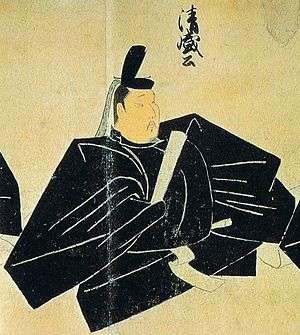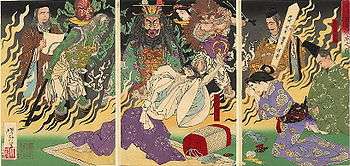Taira no Kiyomori


Taira no Kiyomori (平 清盛, 1118 – March 20, 1181) was a military leader of the late Heian period of Japan. He established the first samurai-dominated administrative government in the history of Japan.
Early life
Kiyomori was born at Ise Province in 1118 as the first son of Taira no Tadamori. His mother Gion no Nyōgo was a palace servant based from The Tale of the Heike. Kiyomori was the son of Emperor Shirakawa with Gion no Nyogo who was given to Tadamori.
Family
- Father: Taira no Tadamori
- Mother: Gion no Nyogo (d.1147)
- Wives, Concubine and children:
- Wife: Takashina no Akiko, daughter of Takashina no Motoaki
- First son: Taira no Shigemori
- Taira no Kiyokumo
- Taira no Shigezane
- Taira no Gyojitsu
- Taira no Tadafusa (d.1186)
- Taira no Moromori (1169-1771)
- Taira no Arimori (1164-1185)
- Taira no Kiyotsune (1163-1185)
- Taira no Munejitsu (b.1168)
- Taira no Koremori
- Taira no Takakiyo
- Taira no Rokudai
- Taira no Sukemori
- Second son: Taira no Motomori (1139-1162)
- Taira no Yukimori (d.1185)
- a daughter married Fujiwara no Sueyoshi
- First son: Taira no Shigemori
- Second wife: Taira no Tokiko
- Third son: Taira no Munemori
- a daughter married Taira no Michimori
- Taira no Kiyomune (1170-1185)
- Taira no Hiramune (1178-1185)
- Forth son: Taira no Tomomori
- Taira no Tomoakira (1169-1184)
- Taira no Masumori
- Taira no Tomotada (1176-1196)
- Taira no Kyoko (b.1181) married Fujiwara noble, had 1 son.
- Taira no Tomomune (1184-1255)
- Taira no Muneshigehisa
- Taira no Morimaru
- Taira no Munesukekuni (1207-1274)
- Taira no Morisaki
- Taira no Muneshigehisa
- First daughter: Taira no Tokuko
- Fifth son: Taira no Shigehira
- Taira no Yoshinori
- Taira no Shigenori
- Sixth son: Ro no Onkata
- Third son: Taira no Munemori
- Concubine: ???
- Second daughter: Taira no Moriko (1156-1179) married Konoe Motozane
- Concubine: ???
- Seventh son: Taira no Tomonori (d.1183)
- Concubine: ???
- Forth daughter: Taira no Hiroko married Konoe Motomichi
- Concubine: Tokiwa Gozen
- Sixth daughter: Ro no Kata
- Wife: Takashina no Akiko, daughter of Takashina no Motoaki
Career
After the death of his father Taira no Tadamori in 1153, Kiyomori assumed control of the Taira clan and ambitiously entered the political realm in which he had previously only held a minor post. In 1156, he and Minamoto no Yoshitomo, head of the Minamoto clan, suppressed the Hōgen Rebellion. This established the Taira and Minamoto as the top samurai clans in Kyoto. However, this caused the allies to become bitter rivals which culminated three years later during the Heiji Rebellion in 1159. Kiyomori, emerging victorious with Yoshitomo and his two eldest killed, was now the head of the single most powerful warrior family/clan in Kyoto. However, his clan's power and influence in the provinces at this time is a matter of debate. Kiyomori showed mercy and exiled a few of Yoshitomo's sons, including Yoritomo, Noriyori, and Yoshitsune – a benevolence that would turn out to be the Taira clan's downfall later on.[1][2]
Due to his status as the head of the sole remaining courtier/warrior clan, Kiyomori was in a unique position to manipulate the court rivalry between the retired emperor, Go-Shirakawa, and his son, Emperor Nijō. Via this manipulation, Kiyomori was able to climb the ranks of government, though the majority of his promotions as well as the success of his family in gaining ranks and titles at court was due to Shirakawa's patronage. This culminated in 1167, when Kiyomori became the first courtier of a warrior family to be appointed Daijō Daijin, chief minister of the government, and the de facto administrator of the imperial government. As was the norm, he soon relinquished the position and leadership of the Taira clan, with the goal of maintaining the social and political prestige of having attained the highest office in the land, but being free of the attendant duties. This had been a common practice for many years in the highest levels of Japanese government and in doing so Kiyomori was asserting what he felt was his strong position in the Kyoto government. However, many of the courtiers from traditional (non-warrior noble families) were less than pleased with both Kiyomori's attainment of power, and how he comported himself with regard to other high ranking courtiers.[1]:266–267
In 1171, Kiyomori arranged a marriage between Emperor Takakura and his daughter Tokuko. Their first son, the future Emperor Antoku, was born in 1178.[1]:268,285 The next year, in 1179, Kiyomori staged a coup d'état forcing the resignation of his rivals from all government posts and subsequently banishing them. He then filled the open government positions with his allies and relatives, and imprisoned the cloistered Emperor Go-Shirakawa. Finally, in 1180 Kiyomori forced the Takakura to abdicate and give Prince Tokihito the throne, becoming Emperor Antoku.[1]:275,285

With the exertion of Taira power and wealth and Kiyomori's new monopoly on authority, many of his allies, most of the provincial samurai, and even members of his own clan turned against him. Prince Mochihito, brother of Emperor Takakura, called on Kiyomori's old rivals of the Minamoto clan to rise against the Taira beginning the Genpei War in the middle of 1180. Kiyomori died early in the next year from sickness, leaving his son Munemori to preside over the downfall and destruction of the Taira at the hands of the Minamoto in 1185.[1]:278,287
The Tales of the Heike states that as he lay dying, Kiyomori's fever was so high that anyone who attempted to even get near him would be burned by the heat.[3]
Cultural references
Taira no Kiyomori is the main character in the Kamakura period epic, the Tale of Heike.
The Daiei Film production of Kenji Mizoguchi's 1955 film Shin heike monogatari (variously translated as Taira Clan Saga, Tales of the Taira Clan, and The Sacrilegious Hero) credits its story as "from the novel by Yoshikawa Eiji", which in turn is a 1950 retelling of the 14th century epic The Tale of the Heike. The opening introduction to the film, in its English subtitles, is
- "Japan, in the Tenth and Eleventh centuries, was virtually controlled by the Fujiwara Clan. But in the Twelfth century, Fujiwara influence began to wane, partly due to the double-monarchy. An Emperor would abdicate but continue to rule from behind the scenes. Thus there was an Imperial Court and an ex-Emperor's Cloister Court, both emperors being descended from the Sun Goddess. Inevitably, there was conflict between the courts. Both began to depend on the warriors, the samurai. Until then, Fujiwara rule had involved little bloodshed. Some monasteries also had their own armies. The monasteries used them to intimidate both courts. Big landowners paid no taxes. Piracy and banditry increased. The Cloister Court attempted to restore order using the warriors of the samurai Taira Clan. Thus were sown the seeds of military governments which dominated Japan for 700 years [i.e., until 1868]. This story begins in 1137, in Kyoto, ancient capital of Japan."
Unlike most other tellings, Mizoguchi's film includes only the story of Taira no Kiyomori's youth, depicting him as a heroic character, particularly in breaking the power of the tyrannical armed monks and their palanquin shrines, where he says at his father's grave "Father, with two arrows from my bow I destroyed a superstition that gripped men for centuries. The courtiers and priests have tried to have me for blasphemy. But others have supported me, more than I expected. Some of them are lords, too. Father, a greater battle lies ahead. But I remain undaunted. No matter how I am beaten, I shall rise again". The film then ends with Kiyomori approaching an alfresco Fujiwara dance, vowing to himself, "Dance, my Lords, dance. Your end is near. Tomorrow will be ours!"[4]
Taira no Kiyomori was featured by 19th century woodblock print artists as an exemplar of guilt and retribution, see the accompanying print by Yoshitoshi. The famous print generally known as The Vision of Kiyomori by Utagawa Hiroshige depicts the actor Nakamura Utayemon IV in the character of Kiyomori, confronted by the horrific vision of his snow-filled garden transformed into the heaped bones and skulls of his slaughtered enemies.
In video games, Kiyomori appears in Warriors Orochi 2 fighting for Orochi's army and using prayer beads as weapons. He also makes an appearance in Dynasty Warriors Strikeforce, as a boss in one of the game's Crossover Missions. Additionally, he is the main antagonist in Harukanaru Toki no Naka De 3.
Kiyomori also features prominently as a sympathetic villain in Osamu Tezuka's Phoenix series in the first half of the ninth volume, Turbulent Times (retitled Civil War in English), another Genpei War epic. Like most villains in the series he desires the titular bird for its immortality granting blood, due to his desire to continue to lead and protect the Taira clan and lack of confidence in his successors, but winds up being tricked into buying an imported peacock instead.
The 2012 NHK Taiga drama was about him.
Honours
- Junior First Rank (11 February 1167)
See also
- Heiji Rebellion
- Taira clan
- Heian Period
- Taira no Shigemori
- Shishigatani incident
- Fukuhara-kyō
- Itsukushima Shrine
- Siege of Shirakawa-den
References
- 1 2 3 4 5 Sansom, George (1958). A History of Japan to 1334. Stanford University Press. pp. 256–259. ISBN 0804705232.
- ↑ Sato, Hiroaki (1995). Legends of the Samurai. Overlook Duckworth. p. 111. ISBN 9781590207307.
- ↑ The Tales of the Heike. Translated by Burton Watson. Columbia University Press. 2006. p. 66. ISBN 9780231138031.
- ↑ DVD Le héros sacrilège, Films sans Frontières 2004